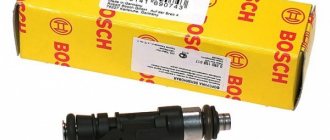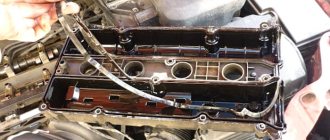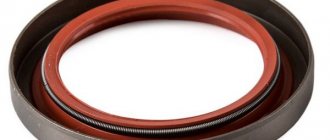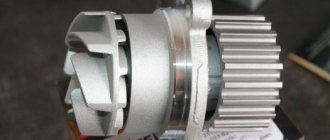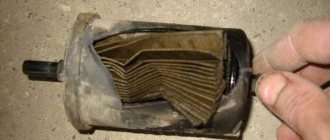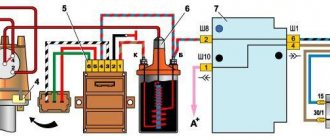What are the dangers of a blown cylinder head gasket?
When a cylinder head gasket burns out, the consequences depend on the time the malfunction was discovered and when the vehicle was stopped from being used. If the gasket only burns out, then you can get by with minimal losses - replacing the gasket itself and related work. When driving with a burnt gasket, the following are possible:
- severe overheating with deformation of the head, which will lead to its replacement, and this is not cheap;
- engine jamming;
- rupture of the cooling system pipes due to high pressure of hot gases.
The consequences of engine seizure may be the need to grind or replace the crankshaft, replace liners, connecting rods or pistons. In the worst case scenario, the cylinder block may need to be repaired.
There are cases when, overnight, through a burnt-out gasket, antifreeze accumulates in the cylinder and during startup, a hydraulic shock occurs with deformation of the head, connecting rod, piston, and crankshaft. If it becomes necessary to start an engine that has been sitting for a long time with a burnt-out gasket, you need to unscrew the spark plugs or injectors (for diesel engines) and crank the crankshaft. Then screw the spark plugs back in and you can start. The described procedure will help to avoid water hammer, which means it will save money and time on repairs.
Considering the consequences that occur after a cylinder head gasket burns out, if any of the above symptoms occur, you should immediately contact a specialist. » alt=»»>
Posts 1 to 25 of 69
1 Topic from Oleg005 12/18/2008 22:33:41
- Oleg005
- User
- Inactive
- Registered: 14.05.2008
- Messages: 179
Topic: Your opinion
Hi all! I would like to get some advice, the result is the following engine: bottom 80 by 84, connecting rod 144, two rings, degree 10.2. Valve cylinder head 31 to 27, stock springs, compensators, shafts 10.5 Stolnikov. Intake: Lada-Sport receiver, throttle 60, exhaust: 4-2-1 further 60. The result is 194 hp. at 7860, torque 191 Nm at 6300. Which shafts from the STI range can be used to stay at approximately these rpms, but get power for 200 hp? A drag car. Don't get me wrong, I've never used STI shafts before, except for not very angry ones, so I'm asking for advice.
2 Reply from Dmitry Zakiev 12/20/2008 12:45:17
- Dmitry Zakiev
- Administrator
- Inactive
- Registered: 03.01.2007
- Messages: 2,570
- User Karma: 41
Re: Your opinion
Our widest hydraulic compensator shaft is 2112 STI-7 with a lift of 9.82.
3 Reply from Oleg005 12/21/2008 08:31:12
- Oleg005
- User
- Inactive
- Registered: 14.05.2008
- Messages: 179
Re: Your opinion
And if there are pushers + springs, but the speed is max. 8500?
4 Reply from Pavel 12/21/2008 11:45:50
- Pavel
- Veteran
- Inactive
- From: Voronezh
- Registered: 22.10.2007
- Messages: 1,420
- User Karma: 46
Re: Your opinion
Try what they offer you - you will like it.
And
5 Reply from Oleg005 12/21/2008 15:26:56
- Oleg005
- User
- Inactive
- Registered: 14.05.2008
- Messages: 179
Re: Your opinion
Try what they offer you - you will like it.
And
Why are you so sure that there is a similar motor that has been measured?
6 Reply from Pavel 12/21/2008 16:58:00
- Pavel
- Veteran
- Inactive
- From: Voronezh
- Registered: 22.10.2007
- Messages: 1,420
- User Karma: 46
Re: Your opinion
Oleg005, you don’t want to screw it above 8500 rpm. And with hydraulics, the maximum “screws” is 8000.
7 Reply from Oleg005 12/21/2008 18:43:39
- Oleg005
- User
- Inactive
- Registered: 14.05.2008
- Messages: 179
Re: Your opinion
I'm considering the option with pushers, but I don't want more than 8500.
8 Reply from Vovan 12/21/2008 22:37:25
- Vovan
- Veteran
- Inactive
- From: Saratov
- Registered: 23.02.2007
- Messages: 1,042
- User Karma: 51
Re: Your opinion
I'm considering the option with pushers, but I don't want more than 8500.
Why increase the engine budget at the cost of pushers and work on their implementation if you plan not to go above 8500?
9 Reply from Serg112 12/22/2008 17:48:06
- Serg112
- Veteran
- Inactive
- From: Nizhny Novgorod region, Sarov
- Registered: 03.04.2007
- Messages: 3,045
- User Karma:
Re: Your opinion
Probably because after about 7500 the hydraulics no longer work. He will be able to install “horse” distributors on the “solid” ones and at his 8500 rpm he will no longer perform like a fool, and not force him.
10 Reply from Oleg005 12/22/2008 19:58:41
- Oleg005
- User
- Inactive
- Registered: 14.05.2008
- Messages: 179
Re: Your opinion
I'm considering the option with pushers, but I don't want more than 8500.
Why increase the engine budget at the cost of pushers and work on their implementation if you plan not to go above 8500?
I already wrote that you need more than 200 horsepower.
11 Reply from Vovan 12/22/2008 23:50:57
- Vovan
- Veteran
- Inactive
- From: Saratov
- Registered: 23.02.2007
- Messages: 1,042
- User Karma: 51
Re: Your opinion
Probably because after about 7500 the hydraulics no longer work..
How is this expressed?
12 Reply from Vovan 12/22/2008 23:52:30
- Vovan
- Veteran
- Inactive
- From: Saratov
- Registered: 23.02.2007
- Messages: 1,042
- User Karma: 51
Re: Your opinion
I'm considering the option with pushers, but I don't want more than 8500.
Why increase the engine budget at the cost of pushers and work on their implementation if you plan not to go above 8500?
I already wrote that you need more than 200 horsepower.
and if this power is achieved at 7500, then don’t turn the extra thousand or see what happens at 8500?
13 Reply from bandit31 12/23/2008 00:43:16
- bandit31
- User
- Inactive
- Registered: 14.06.2008
- Messages: 90
Re: Your opinion
Yes, hydraulics work up to 8500 with really stiffer springs, well, I think it’s cheaper to change the springs to Shrikov’s ones than to switch to pushers, although you can get by with Opel’s red ones (just yellow ones are a little thicker, and they break or bite, though installed on one Opel engine CX20DE)
By the way, at such speeds, put 4-1 u-power or something like that
Reasons for gasket burnout
There are few reasons why a cylinder head gasket burns out, but with a new engine there is only one – overheating. Even a short time of engine operation at temperatures above normal can cause this malfunction. In this case, the gasket may burn out quite a bit, and inexperienced motorists will not notice the first symptoms that appear. With further operation, the burnout increases, and the symptoms become more pronounced. Due to the fact that many car owners turn to specialists not after overheating, but after some time of operation, when the malfunction becomes a clear fact, they do not connect the burnout of the gasket with the recent overheating and demand from motorists other explanations why the cylinder head gasket burned out.
If the volume of coolant is insufficient, you may not notice a slight overheating of the head, since the liquid, circulating in the system, manages to cool in the radiator, but does not have time to remove heat in the required amount. Instruments in a car show the temperature of the coolant, not the temperature of the engine parts. Thus, when operating a car with an insufficient level of antifreeze, you can burn the gasket without realizing that the cause was overheating.
Burnouts occur due to poor-quality gaskets, but this mostly applies to engines after repair. This happens extremely rarely on new cars. Even on repair engines, the cause of such a malfunction may be factors related to the quality of the repairs performed:
- unsatisfactory condition of the mating surfaces (remains of the old gasket, shells or scratches on the surfaces are poorly cleaned, head deformation);
- incorrect tightening torque of the cylinder head bolts;
- the order of tightening the cylinder head bolts is incorrect;
- the thickness of the gasket is incorrectly selected (on engines where they come in different sizes).
Product added to bookmarks!
- Description
- Reviews
APPLICABILITY: 16V engines VAZ 21126 (1.6L), 21127 (1.6L), 21129 (1.6L), 21179 (1.8L) with a cylinder diameter of 82-84 mm
.
Federal Mogul is a leader in the aftermarket industry - a leading supplier of a full line of engine parts, fuel pumps, water pumps, CV joints, CV joints, struts and shock absorbers, ball joints, ignition products, brake friction materials, steering ends, bushings and other parts. for the chassis.
The VAZ 21126 (Priora) engine is equipped with a metal, two-layer head gasket with spring ridges to seal the gas joints and the lubrication system channel.
This gasket can be installed in VAZ 2112, 21124 and 21128 engines in order to increase the compression ratio.
The thickness of the VAZ 21126 head gasket in a compressed state is 0.45-0.50 mm, volume 2.76 cm3.
It is important to remember that the distance from the piston at TDC to the cylinder head plane should not be less than 0.8 mm.
Before installation, it is necessary to determine the design compression ratio.
Symptoms of a burnt cylinder head gasket
Most drivers do not know how to check whether the cylinder head gasket is blown. It's actually quite simple. The following symptoms indicate a failure of the cylinder head seal:
- knocks antifreeze out of the cooling system;
- cold air flows from the interior heater when the coolant supply valves to the heater are open;
- engine temperature jumps;
- the presence of a water-oil emulsion or water droplets on the oil dipstick;
- breakthrough of gases and/or process fluids (antifreeze, oil) between the cylinder block and the head to the outside of the engine.
Knocks out coolant
Problems with coolant, without signs of leakage from the system, are clear signs of a violation of the integrity of the gasket. When the gasket between the combustion chamber and the coolant channel burns out, high-pressure gases break into the cooling system, create excess pressure and squeeze the coolant through the expansion tank plug.
If the tank cap is tightened tightly, as it should be, and the safety valve in it is faulty, the rubber pipes of the cooling system may burst due to excess pressure, or the burnout area will expand, with gases escaping into the oil channels. More often the latter option happens.
If, with such a burnout, you start the engine with the cap removed from the expansion tank, then through its neck you can observe the appearance of gas bubbles in the coolant. As the engine speed increases, the number and size of the bubbles will increase, the level of liquid in the tank may rise significantly, with gases suddenly escaping from it - these are symptoms of a burnt-out cylinder head gasket.
Cold air from the heater
This sign is very reliable, but due to design features, it does not appear on all cars. With a small burnout, gases can weakly break into the cooling system and manage to escape through the valve of the expansion tank plug. But in some cars, escaping gases accumulate in the interior heater core, creating an “air lock.” The air lock blocks the circulation of liquid through the stove and the air coming out of it does not heat up. It should be noted that not many experienced drivers know why the circulation of antifreeze through the heater radiator stops.
In order to check that the cause of cold air in the stove is a burnt-out cylinder head gasket, the following steps are necessary:
- Open the antifreeze supply valve to the heater radiator.
- Remove the pipe at the outlet of the radiator and after antifreeze flows out of it, put it on again.
- Make sure that warm air is coming from the interior heater.
The time it takes for an air lock to form in the heating system depends on the degree of gasket burnout and engine operating modes. This factor attracts attention in cold weather when the driver uses the car’s heater.
Engine temperature surges
The fact that the cylinder head gasket has burned out is indicated by symptoms associated with the temperature of the antifreeze. Gases breaking into the cooling system in small quantities can escape through the valve of the expansion tank plug without knocking out the antifreeze. Some of the gases accumulate in front of the thermostat, partially blocking the heat transfer of coolant to it. As a result, the thermostat operates late, which leads to excessive heating and possibly overheating of the motor.
After the thermostat activates, the temperature drops sharply and then everything repeats again. Frequent temperature fluctuations are classic signs of a blown gasket, but if they are not accompanied by bubbles in the expansion tank, then the problem may be a faulty thermostat. Therefore, the first thing you need to check is the thermostat.
Other obvious signs of a broken gasket
In the case where obvious oil leakage or exhaust gas breakthrough could not be diagnosed, you have to deal with more complex consequences of gasket burnout:
- White emulsion on the oil dipstick or under the oil filler plug on the timing cover. This indicates that coolant entered the lubrication system through a damaged gasket. At the same time, the oil level will rise and the antifreeze level will fall. This will be another clue to find out the causes of the malfunction. In most cases, repairs are limited to replacing the gasket and oil with antifreeze, although sometimes cracks occur in the oil channels themselves or in the water jacket channels, then replacing the block or head is in order.
Necessary parts and tools for repair
Troubleshooting the cylinder head begins with the purchase of original parts and various consumables, the list of which is as follows:
- Fuel intake system valve 8 pcs. (art. 21120-1007010).
- Exhaust gas valve 8 pcs. (art. 21120-1007012).
- Set of hydraulic compensators 16 pcs. (art. 21120-1007300).
- Gaskets for valve cover, cylinder head, intake manifold, exhaust manifold (all come as a set art. 21120-1002064-86).
- Bolts securing the cylinder head to the engine crankcase (art. 21120-1003271-018).
- Timing belt (art. 2112-1006040-02RU), timing tension roller (art. KT100507/100513), drive belt for mounted units (art. BP638).
- Engine oil and oil filter.
- Cooling system fluid.
Installation of valves on a VAZ 2112 is carried out using a standard set of tools, as well as several specialized types of keys:
- standard set of spanners from 8 to 24 mm;
- socket sockets in a set from 8 to 27 mm;
- end internal hexagons;
- mechanical valve retaining ring remover (depressurizer);
- torque wrench for tightening the cylinder head and camshaft bolts;
- paste for grinding valves (set for rough and fine grinding);
- metalworking cloth gloves to protect hands while working.
The work of replacing 16 valves on a VAZ 2112, the price of which as of this fall is about 50 thousand rubles at AvtoVAZ dealerships (or approximately 35-40 thousand rubles at ordinary car repair shops), is not a very complicated process. You can carry out the work yourself, for which it is enough to purchase the above-described spare parts and the necessary tools.
